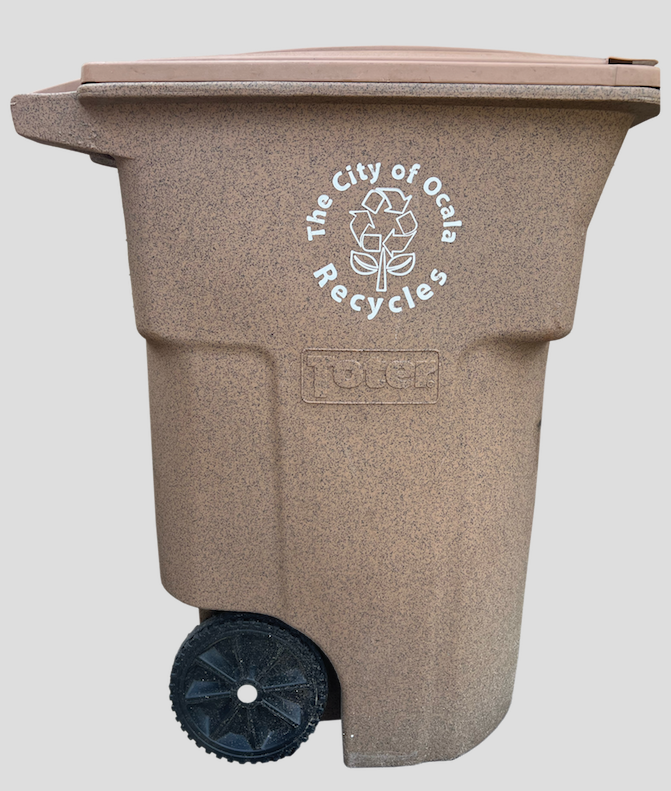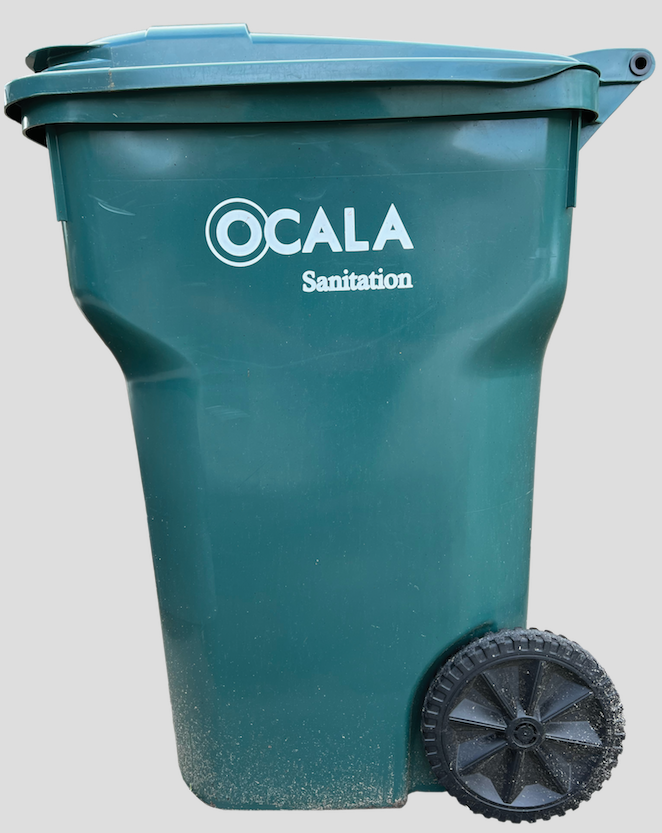The Two Sides to the Trash Can Debate
A breakdown of the garbage disposal dispute between Friends Recycling Center and the City of Ocala: Part 1 of 2

Over the last several months, Jerry Laurenco, owner and operator of Friends Recycling Center (FRC) in Ocala, has attended numerous Ocala City Council meetings with a single request: Will the city recognize his facility the same way the state does, that is, as a Materials Recovery Facility, or MRF?
And the city has responded, time and again, that per city code, it only recognizes FRC as a recycling center.
But what’s the difference? And, importantly, why does this matter to city residents? Because some would argue that with garbage costs rising, a more competitive market could help drive down prices for consumers.
What’s the Dispute?
It all starts with the green and brown receptacles that Ocala businesses and residents use. Brown is for recyclable items. The contents in the brown receptacles go to a recycling center. Green is for garbage. This content goes to the landfill.
That’s how the city sees it. No gray areas, just green and brown. No matter what the state says FRC can do, Ocala officials say the city code supersedes the state.
Laurenco insists state rules allow him to operate his recycling center as an MRF. This would allow him to receive both brown and green receptacles and sort out the recyclable items from both, since both kinds of receptacles typically contain a certain amount of garbage along with recyclables. This mixture is called contamination.
Contamination originates from human error, when citizens do not properly differentiate between which receptacles they place their recyclable items and/or garbage. A significant amount of misplaced garbage or “contamination” occurs before either garbage or recycling trucks arrive to collect their respective containers.
Laurenco wants the city to rewrite its code to include MRFs in the ordinance language, allowing him to operate his facility as designed, something it cannot currently do within city limits.
But so far, the city has stood by its code.
Assistant City Manager Pete Lee said on March 8 that the city looks at the issue differently than does the Florida Department of Environmental Protection.
“We don’t try, nor should we try, to mirror the state’s definitions,” said Lee of how the city defines recycling center. “The state regulates what it regulates and we have simply divided it into trash and recyclables: brown container versus green container. We know there is going to be some contamination in brown containers, but the intent, the presumption is that those containers primarily contain recyclable materials.”
On March 1, Ocala City Council instructed city staff to look into and provide some alternative options on how the current code could be rewritten to possibly include such terms as “MRF” or “Recovered Materials Facility.”
The issue will be discussed at a strategic work session on Tuesday.
Dirty and/or Clean MRF
Currently, FRC meets the city’s definition of a recycling center. But to the state, FRC also meets the definition of a “dirty MRF.”
Under DEP regulations, no more than 10% of the contents of each truck that enters the FRC site can be contamination. At that level, the site is considered a so-called “clean murf.’’ If more than that, the facility is considered a “dirty murf’’ and must be properly permitted by the DEP.
Obviously, it is impossible to know whether a truck’s load has 10% or less contamination until the contents are dumped out on the floor and inspected. Preferably, a MRF is designed and equipped to handle both clean and dirty levels of contamination at any given moment.
To be a state-permitted “dirty” MRF, the facility must also have a leachate collection system. Leachate is liquid generated from rainfall and the natural decomposition of waste. A “clean’’ MRF doesn’t require a leachate collection system.
FRC is permitted through the DEP to accept Class 1 garbage (defined as potentially toxic or dangerous waste) and Class 3 garbage (includes inert, insoluble material, e.g., rock, glass, bricks and dirt) as well as C&D (construction and demolition) debris, which commonly consist of drywall, concrete, wood and metal, as well as yard waste.
Also in the refuse business are transfer stations, where garbage trucks dump their loads on the ground, front-end loaders scoop it up and put it into semi-trailers, which then take it to a landfill.
Ocala’s codes don’t recognize transfer stations, either.
FRC’s Side
“The DEP don’t care what color the (receptacle) is,” said Laurenco, “they care about what’s on the ground, what’s in the (receptacles) and how it’s sorted.”
On average, he said, recycling loads brought to FRC carry at least 25% contamination, and many loads often contain much more than that. Any loads with over 10% contamination, regardless of what percentage of recyclable materials might still be included, per DEP, must be brought to the landfill.
To Laurenco, this is an incredible waste of recyclable materials. And it all stems, he said, from an outdated code. The city’s recycling center code definition was enacted in 1992 and Laurenco said it no longer reflects what’s happening on the ground—and in the garbage cans.
“It just isn’t realistic. There’s not a garbage truck picking up recyclables anywhere in Florida that’ll have [less than 10% contamination],” said Laurenco. “So, you’re in violation just by picking it up, because they’re always going to be more. I’m in violation as we speak.”
The Florida Legislature, through the Energy, Climate Change and Economic Security Act of 2008, established a statewide weight-based recycling goal of 75% by 2020. The act directed the DEP to establish a reporting protocol and directed counties to report annually.
Florida reached its interim goals for 2012 (40%) and 2014 (50%); however, it did not meet its 2016 (60%) or 2018 (70%) interim goals. In fact, the recycling rate has continued to decline since 2014.
Based on the DEP’s evaluation of available data, the drop can largely be attributed to a reduction in the reported amount of C&D debris recycled in 2018.

Ocala’s Side
Lee, Ocala’s assistant city manager, said the city takes a different, and simpler, view of things.
“The percentage [of contamination] doesn’t matter to us. It may matter to the DEP, but intent matters to us,’’ he said.
“If Jerry picks up brown cans, takes them to his recycling center and dumps them on the floor, it’s legal. If he picks up green cans and dumps them on the floor, it’s illegal. It’s that simple. He’s a recycling center. It’s not calculus.”
For the city, the source is all. The current code as written doesn’t recognize or differentiate MRFs—dirty or clean. You are a recycling center or you are not, according to the city, you pick up brown cans or you do not. Green cans are picked up by the City of Ocala, using their own trucks, then transported to GFL Environmental Inc.—Ocala’s current solid waste disposal provider, which has a contract valid through Sept. 30, 2025.
The Ocala City Council will consider options presented by the staff on how the current code could be rewritten.
“It’s not impossible to change the definitions,” admitted Lee. “It’s just a matter of the intent of those definitions remaining clear. We need to be careful about where these facilities might be located in the county. There’s a lot to talk about.”
Tagging
Along with its brown container vs. green container ordinance, the city also has a council-approved tagging program.
If a load comes in over 10% contamination, the original bin will receive a yellow tag warning on a first violation. City personnel will reach out with a letter and speak to the resident. If it happens again, the bin will receive a red tag and the city will send another letter.
On a third offense, the city pulls that bin from rotation and trucks will no longer pick up that trash.
Director of Public Works Daren Park recently told the city council that Ocala has issued almost 2,600 yellow tags and almost 400 red tags, pulling about 223 receptacles.
The city has almost 11,000 accounts, Park said, and over 2,400 receptacles that are serviced six days a week, Monday through Saturday.
Next Steps
Councilmembers Kristen Dreyer and Barry Mansfield have both raised concerns over why the city hasn’t opened things up for competitive bids regarding who hauls its garbage, in the hope of driving down the price passed onto the citizen consumer.
At the March 1 city council meeting, Dreyer specifically addressed what she called a “monopoly on our garbage situation right now.”
“That’s not in the best interest of our taxpayers to have one company that can address our garbage,” she said. “If [Laurenco’s] facility was open or someone else’s facility in town that could serve the same purpose, it would save us, if he were bidding our work $250,000 a year—because he would pull out the recyclables on average, and then send less garbage to the landfill. I think that’s to everyone’s benefit.”
At the end of the day, Laurenco said he just wants to operate his facility the way it was designed and permitted through the DEP to operate. His hope is that city council will amend its code’s language to better reflect more nuanced definitions of what a “recycling center” can be.
After the March 1 City Council meeting, Laurenco admitted to feeling optimistic about where things might be going.
“I think they’re finally starting to understand it better,” said Laurenco on March 2. “I mean, to me, I’m one of those keep-it-simple-stupid guys. Let’s not complicate something that doesn’t need to be complicated. Let’s have the code fit the facilities that we have.”
On March 15, Laurenco asked the Ocala City Council at its regular meeting, while the city staff was discussing possible rewrites to the code, if he could operate as a MRF.
Jimmy Gooding, an attorney for the city, told Laurenco that if he believed he was operating consistently with the city code as it was currently written, then he could continue to do so, but nothing more.
“You may be legal per DEP,” said Gooding, “but if you’re not legal per the city code, then the city has the ability to pursue you for violations,” adding that at the present time the city had no knowledge of any ongoing violations.
“If you think you’re consistent with the current code as written, then take your chances,” he said. “If you want to wait and be sure after [city staff] processes something to city council, then you can do that. But just because you have permission from DEP to do something does not mean you can do it under the city signing code.”
Assistant City Manager Ken Whitehead also said that city staff had met with the city attorney’s office on March 7.
“We talked a lot about what an ordinance would need to look like if council wanted to go in that direction [rewriting the city code]. That draft is being worked on as we speak,” he said.
Part two of this two-part series will include follow-up from the DEP, as well as follow-up on what city staff brings forward to the city council concerning alternative language to the current city code.





